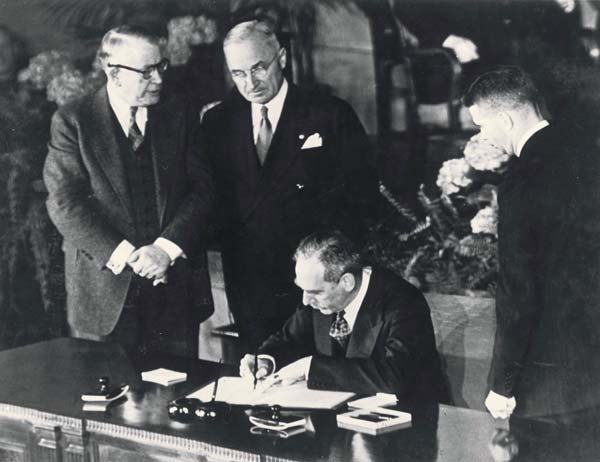
From the Harry S. Truman Presidential Library and Museum: The North Atlantic Treaty–the first peacetime military alliance ever concluded by the United States–was signed by the foreign ministers of the twelve signatory nations on April 4, 1949. The signing ceremony occurred in an auditorium near the White House in Washington, DC. Secretary of State Dean Acheson signed for the United States, with President Truman standing beside him. Just prior to the signing of the treaty, Truman spoke to the foreign ministers and the others present in the auditorium. "In this pact," he said, "we hope to create a shield against aggression and the fear of aggression–a bulwark which will permit us to get on with the real business of government and society, the business of achieving a fuller and happier life for all our citizens. . . ."
President Truman sent the North Atlantic Treaty to the Senate for consideration on April 12, 1949. During lengthy hearings before the Senate Foreign Relations Committee many witnesses expressed concern and dismay at the prospect that the United States would abandon a tradition of nonentanglement with Europe that was as old as the Republic, and others worried that the proposed military alliance would conflict with the purposes of the United Nations. Despite these concerns, on July 21, 1949 the Senate advised Truman that it favored ratification. On July 25 the North Atlantic Treaty was formally ratified by the President in a signing ceremony in the Cabinet Room. At a ceremony in the Oval Office on August 24, 1949, with Dean Acheson and representatives of the signatory governments gathered around him, President Truman formally accepted the instruments of ratification and announced that the North Atlantic Treaty was in effect.
"By this treaty, we are not only seeking to establish freedom from aggression and from the use of force in the North Atlantic community, but we are also actively striving to promote and preserve peace throughout the world." Harry S. Truman, August 24, 1949
From the National Archives: In his memoirs, Dean Acheson recalled "All the North Atlantic Treaty ministers met in Washington on April 2 to approve the draft treaty and arrange for its signature at a ceremony set for April 4. Here President Truman again showed his consideration for me. I had told him that it would be appropriate and fitting for him to sign the treaty on behalf of the United States, but this he refused to do. He would attend the ceremony and stand beside me as I signed, but the treaty would bear my name."
The North Atlantic alliance created a military and political complement to the Marshall Plan for European economic recovery by establishing a mutual defense pact against possible aggression from the Soviet Union.
From NATO: The hostilities that had characterized relations between soviet and western powers since 1917 gradually re-emerged at the end of the Second World War. This “East-West” divide was fuelled by conflicting interests and political ideologies. There were clashes over peace agreements and reparations, and tensions were exacerbated by events such as the Berlin blockade in April 1948, the June 1948 coup in Czechoslovakia and direct threats to the sovereignty of Norway, Greece and Turkey.
As the power of the Soviet Union spread to several Eastern European countries, there was concern among Western European countries that the USSR would impose its ideology and authority across Europe. From 1945, Western governments started reducing their defence establishments and demobilizing their forces. But in January 1948, Bristish Foreign Secretary Ernest Bevin spoke of the need for a “treaty of alliance and mutual assistance”, a defensive alliance and a regional grouping within the framework of the UN Charter.
The United States would only agree to provide military support for Europe if it were united. In response, Belgium, France, Luxembourg, the Netherlands and the United Kingdom, signed the Brussels Treaty in March 1948, creating the Western Union. Designed to strengthen ties between the signatories while providing for a common defence system, the Brussels Treaty ultimately became the basis for the Washington Treaty.
In the meantime, the US Senate adopted the Vandenberg Resolution – a resolution that would change the course of American foreign policy since it allowed the United States to constitutionally participate in a mutual defence system in times of peace.
From NATO: While the signing of the North Atlantic Treaty had created Allies, it had not created a military structure that could effectively coordinate their actions. This changed when growing worries about Soviet intentions culminated in the Soviet detonation of an atomic bomb in 1949 and in the outbreak of the Korean War in 1950. The effect upon the Alliance was dramatic. NATO soon gained a consolidated command structure with a military Headquarters based in the Parisian suburb of Rocquencourt, near Versailles. This was Supreme Headquarters Allied Powers Europe, or SHAPE, with US General Dwight D. Eisenhower as the first Supreme Allied Commander Europe, or SACEUR. Soon afterward, the Allies established a permanent civilian secretariat in Paris, and named NATO’s first Secretary General, Lord Ismay of the United Kingdom. (photo: NATO) (Additional video of speech by President Harry Truman at signing of North Atlantic Treaty)
Image: nato%204%204%2012%20Dean%20Acheson%20signing%20treaty_0.jpg
